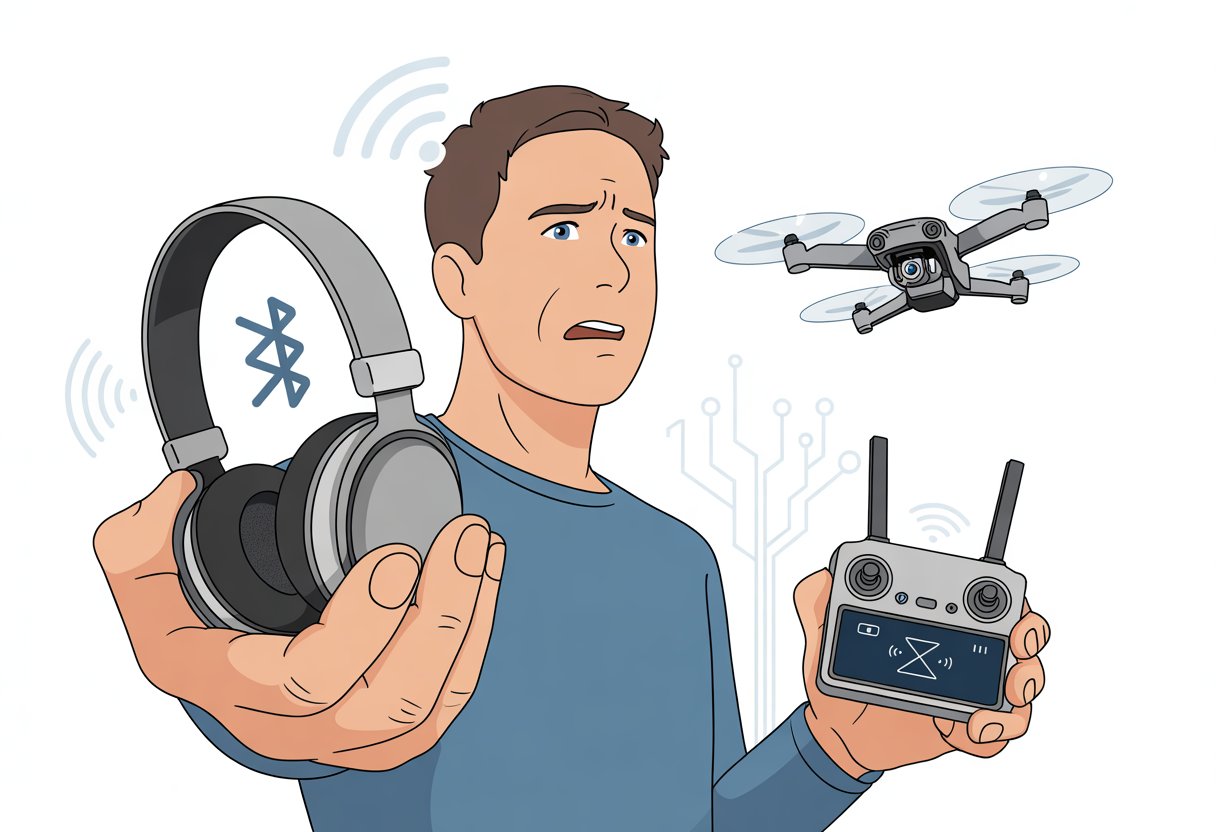Ever tried to pair your favorite Bluetooth headphones with your drone remote, only to end up talking to yourself? We’ve been there, pushing buttons, hoping for a miracle.
It’s kind of like asking a goldfish to fetch—no matter how many times you try, it’s just not happening.

Most drone remotes don’t support audio output through Bluetooth, so our Bluetooth headphones won’t work with them. These remotes focus on flying the drone, not on playing our playlists or epic soundtracks.
You won’t find a headphone icon anywhere on the remote, and that’s not by accident.
If you’re still determined to make it work, let’s sort through the tech mess together. Maybe we’ll find a workaround—just don’t expect a miracle.
Common Reasons Bluetooth Headphones Won’t Connect to Drone Remotes
Bluetooth headphones and drone remotes don’t always get along. Sometimes, it feels like they’re talking past each other, or just ignoring each other completely.
Incompatible Bluetooth Protocols
Honestly, not all Bluetooth is the same. Your headphones might support the latest audio profiles, but drone remotes usually keep things simple.
Most remotes only support certain Bluetooth versions, and they’re usually meant for connectivity, not high-quality audio. Your headphones need something like A2DP for stereo sound, but most remotes just don’t have it.
Some remotes only use Bluetooth for things like firmware updates or transferring data, not for streaming audio. So, your headphones might try to connect and then give up after a few seconds.
Security standards can also get in the way. If your headphones and remote don’t trust each other’s Bluetooth security, they’ll just refuse to connect.
Limited Bluetooth Functions on Drone Remotes
We wish drone remotes could do everything, but most are pretty focused. They connect to your phone, your tablet, or the drone itself—leaving Bluetooth headphones out of the action.
Manufacturers cut out extra Bluetooth features to avoid distractions and keep the remote focused on flying. Some controllers use Bluetooth only for software updates or tweaking settings, so there’s no support for audio playback at all.
If you try to pair your headphones, they might pop up on a pairing screen for a second, then disappear before you can connect. Sometimes, the remote doesn’t even notice your headphones exist.
Since there’s no Bluetooth audio support, you won’t get alerts or commentary in your headphones. All those warnings? Straight from the remote’s tiny speaker, and good luck hearing it outside.
Hardware Restrictions
If only we could just upgrade our remotes with better Bluetooth. Most remotes focus on keeping latency low and signals clear, so they push audio features way down—or just leave them out.
Bluetooth antennas in these remotes are tuned for connecting to the drone, not juggling audio with headphones and all the other wireless noise. It’s like trying to sing karaoke at a busy airport—just not going to work.
Some remotes just don’t have the right chips for stable Bluetooth audio. Even newer models might only offer basic connectivity if the manufacturer decides audio isn’t a priority.
You could try using an external Bluetooth transmitter or plug your headphones into your phone, but connecting directly to the remote? That’s usually a dead end.
Pairing Process: Where Things Go Terribly Wrong
Trying to pair Bluetooth headphones with a drone remote feels like hide-and-seek, except no one’s actually seeking. When it doesn’t work, who’s to blame—your headphones, the remote, or maybe just bad luck?
How Pairing Usually Works
Normally, you press and hold a button on your headphones until a little light blinks like crazy. That means they’re in pairing mode, searching for a new friend.
Then you look for the headphones’ name on your device’s Bluetooth list and tap it. If everything lines up, the devices connect and you’re good.
Sometimes, even this goes sideways if the battery’s low or the headphones aren’t discoverable. That’s pairing basics, but things get weird with drone remotes.
Miscommunications Between Devices
Here’s where things get awkward. Some drone remotes use different Bluetooth standards or profiles. Your headphones might expect A2DP for audio, but the remote only supports basic connections for its app or accessories.
It’s like trying to high-five someone who wants a handshake. If the devices don’t speak the same Bluetooth language, they just blink at each other and nothing happens.
Firmware or app issues can also block pairing. Updating both devices might help, but if the standards don’t match, no update will magically fix it. Sometimes, it feels like trying to connect a potato to a toaster.
Difference Between Pairing With Phones vs. Remotes
Pairing with a phone is easy—phones are built to connect to Bluetooth headphones and support most profiles. Unless something’s wrong, it just works.
Drone remotes are a different story. They’re built to control the drone, not to play music or audio. If you check the manual, you won’t find Bluetooth audio—just instructions for connecting to the drone or app.
Phones are social butterflies, but drone remotes are lone wolves. They usually only want one kind of connection and don’t care about your headphones. Sometimes, tech just doesn’t care about your playlist.
Drone Remote Audio Systems: Not Quite a Concert Hall
Let’s be honest—drone remotes aren’t winning any sound awards. Bluetooth headphones and drone remotes just don’t harmonize, and there’s a good reason for that.
Why Most Drone Remotes Don’t Transmit Audio
Drone remotes focus on sending control signals, not music or podcasts. They talk to your drone using radio frequencies and care about stability, not surround-sound.
When you try to pair Bluetooth headphones, you get silence. Unless the remote was built for audio output (almost none are), there’s simply no audio signal.
Bluetooth can also mess with the radio frequencies used by the drone and remote. That’s another reason manufacturers avoid adding audio features. So, no playlists while flying—sorry.
Intercom Expectations vs. Reality
Maybe you picture yourself talking to your drone through a remote intercom, like mission control. But drone remotes don’t have intercom functions like airplanes do.
Unlike aviation headsets, drone remotes don’t need to talk back and forth with the drone. No audio feedback, no “Maverick, you’re too low!”—just beeps and alerts.
If you want more than a beep, you’re out of luck. Drone remotes are all business, no karaoke.
Aviation Headsets vs. Casual Bluetooth Headphones
Aviation headsets are built for cockpits, drowning out engine noise and letting pilots communicate. They use special plugs and radios for aviation, not for Bluetooth music.
Bluetooth headphones are made for music and calls, not for handling propeller noise. They connect to phones or computers—not to drone remotes.
Trying to use casual Bluetooth headphones with a drone remote is like plugging a toaster into a car. The pieces don’t fit, and all you get is silence. At least you won’t hear complaints about noise.
Active Noise Reduction Features: A Blessing and a Curse
Active noise reduction in Bluetooth headphones can make your music sound amazing. But when you try pairing them with drone remotes, that same feature can turn into a problem.
How Active Noise Reduction Messes With Connectivity
Active noise reduction (ANC) doesn’t just block noise—it uses tiny mics and signal processing to cancel background sounds. That’s great, until it starts messing with your connection.
Headphones with ANC drain battery faster, which can cause Bluetooth dropouts right when you need them. And the lag between what the drone “hears” and what you hear? ANC can add extra processing time, making delays worse.
Some headphones even turn off ANC if they detect a weak connection, making things even more confusing. If your ANC headphones refuse to connect, the battery might be too low—especially on models where ANC only works wirelessly, like these headphones.
Device Compatibility When Silence Isn’t Golden
A lot of drone remotes just don’t work well with fancy headphones—especially ones that need special Bluetooth profiles. Many drones can’t use Bluetooth audio in real-time, and that’s a problem if your headphones insist on digital noise canceling or special codecs.
Some ANC features can interfere with the remote’s wireless signals, causing stuttering or disconnects. Not exactly what you want mid-flight.
You might also find that headphones disable volume control or ANC in certain modes. With wireless-only ANC, the feature won’t work if you use a cable or with devices that don’t support Bluetooth well. If you want silence while flying, you might have to leave ANC at home.
Keeping the Power On: The Battery Connection
Let’s talk batteries. Sometimes, your headphones act like they’ve pulled an all-nighter with no coffee.
When Bluetooth headphones or drone remotes start acting up, the real culprit might just be the battery—especially if you’re running on those trusty old 2 AA batteries.
Battery Requirements of Headphones
Bluetooth headphones can be surprisingly picky about power. Most of the time, they need a steady stream of juice to connect smoothly with any device—even a drone remote. When the battery dips too low, you’ll probably notice spotty connections, random shutdowns, or headphones that just refuse to pair. It’s a bit like trying to negotiate with a toddler who’s set against vegetables.
Let’s be honest: keeping our devices fully charged is one of those easy wins we sometimes forget. Some headphones start acting up with even a small drop in power—think sound lagging behind the video or random disconnects. If you want your headphones to play nice with your drone remote, giving them a full charge is a no-brainer.
If you use rechargeable headphones, make charging part of your routine. Maybe right after you feed the dog, but before you realize you left home with just one earbud in.
Troubleshooting With 2 AA Batteries
Some drone remotes and certain headphones go old-school and run on 2 AA batteries. These little cylinders look harmless, but they’re the unsung heroes of so many gadgets. One weak battery can throw everything off.
When things start acting weird, try swapping both batteries for fresh ones. Old AAs love to pretend they’re fine while secretly going on strike. If the issue sticks around, maybe a faulty charging cable or a poor battery connection in the remote is the real culprit.
Here’s a tip: mixing old and new batteries is never a good idea. Use a fresh pair, and double-check the orientation—nobody likes realizing the AAs were upside down after half an hour of troubleshooting.
Top Alternatives for Getting Audio From Your Drone Remote
Let’s be real, getting perfect Bluetooth audio from a drone remote is like herding cats—it sounds easier than it actually is. When wireless headphones just won’t cooperate, it’s time to get creative. Luckily, there are a few solid workarounds that don’t need Bluetooth at all.
Using Wired Headphones (It’s Not That Bad)
Sometimes, the old ways really are the best. Most drone remotes come with a 3.5mm headphone jack or audio output. Just grab a pair of wired headphones and you’re set.
Yeah, you might look like you raided your parents’ attic for gear. But the connection is rock solid, and there’s no lag. Plus, you never have to worry about charging another battery or fighting with dropped Bluetooth signals.
If you care most about reliability, wired headphones are the MVP. The cable can get in the way, but at least you’ll hear those important drone beeps instead of missing them because of a failed pairing.
| Pros | Cons |
|---|---|
| Stable audio | Wires tangle |
| No batteries | Limits motion |
| Simple setup | Less stylish |
External Audio Adapters: Double the Fun
If you’re not ready to give up on wireless sound, an external audio adapter could save the day. These little Bluetooth transmitters plug into your remote’s audio jack and beam the signal straight to your headphones.
Most adapters are tiny—about the size of a thumb drive. They let you keep your favorite wireless headphones, but without the headache of fighting with the remote’s built-in Bluetooth (which, honestly, sometimes isn’t even there).
There are a couple trade-offs. You’ll need to keep the adapter charged, and there might be a tiny bit of audio lag. Still, if you want fewer cords and a bit more freedom, picking up a Bluetooth transmitter can be a solid move.
Upgrading to Aviation-Grade Solutions
If you want the ultimate drone audio, maybe it’s time to think big—aviation big. Aviation headsets were made for pilots dealing with noisy cockpits, so they’re pros at blocking out rotor noise and wind.
Some high-end drone remotes work with aviation headsets using special adapters. This setup lets you hear every beep and warning, even in the middle of a windy field. Suddenly, you’re not just flying a drone—you’re ready to pilot a plane.
Aviation headsets don’t come cheap, and your drone backpack might gain a few pounds. But the comfort, audio clarity, noise cancellation, and tough build can make you the envy of the park. Just maybe don’t wear one at your local coffee shop unless you’re aiming for attention.
Final Tips and Tricks for Trouble-Free Listening
Nobody wants to ruin their flying soundtrack because of a few Bluetooth hiccups. With some quick checks and a little know-how, you can keep your music, calls, and flight instructions working together—no silent skies or tangled messes.
Checking Compatibility Before Takeoff
Let’s be honest, not every Bluetooth headphone pairs up nicely with every drone remote. Before you launch, check if your drone remote actually supports audio output over Bluetooth. It’s not always standard—lots of remotes just don’t do Bluetooth audio.
It’s smart to double-check the Bluetooth versions on both your headphones and remote. Most new gadgets use Bluetooth 5.0, but if your drone remote is stuck on Bluetooth 4.0, things might not work out. Compatibility goes beyond Bluetooth versions, too. Some headphones use special audio codecs, while some remotes keep things basic.
If you’re unsure, a quick look at the drone manufacturer’s website or the remote’s settings can save you a lot of frustration. User forums are another goldmine—other people have probably run into the same issues. You’ll find more on device compatibility in this guide on Bluetooth headphones.
When To Consult the Drone Manual
Nobody loves reading manuals, but sometimes it’s the only way forward. The manual usually lists which accessories work, and how to pair them. You might even find out if Bluetooth audio is supported, or stumble onto a hidden setting you missed.
If pairing fails, check the manual for tips on resetting the Bluetooth connection, updating firmware, or toggling weird settings you didn’t know existed. These steps are often quicker than randomly poking around menus or blaming your headphones.
Most manuals are online these days, so you can search for the digital version. Sometimes, you’ll even get troubleshooting FAQs or video walkthroughs—no paper cuts required.
Adopting Backup Communication Methods
Sometimes, no matter how hard we try, our headphones just won’t get along with the drone remote over Bluetooth. That’s when it’s time to pull out a good old “Plan B.”
If your remote has a headphone jack, you can grab some wired headphones. It’s not fancy, but hey, it usually works when wireless options refuse to cooperate.
You could also try a small external Bluetooth transmitter. Just plug it into the remote’s audio output—assuming there is one. This little gadget acts as a go-between for your remote and headphones, sidestepping all that built-in Bluetooth hassle.
If nothing else works, just listen for the drone’s beeps or keep an eye on the app notifications on your phone or tablet. Sometimes, those basic alerts are honestly the easiest way to dodge disaster—for your drone and your music.
Need more help? You can always check out this Bluetooth headphone fix guide.
- Best Fitness Trackers for Kids Who Move Faster Than Your Wi-Fi - December 1, 2025
- How to use Bluetooth headphones with gym equipment without looking like a techno-ninja - December 1, 2025
- Best Smartwatches for Strava: Track Your Sweat in Style - December 1, 2025






